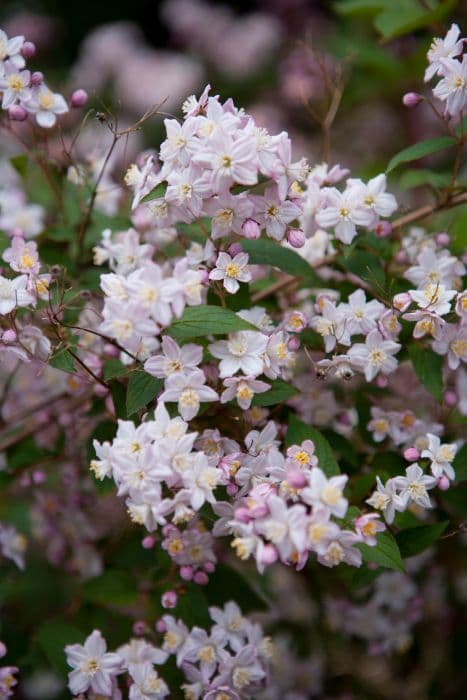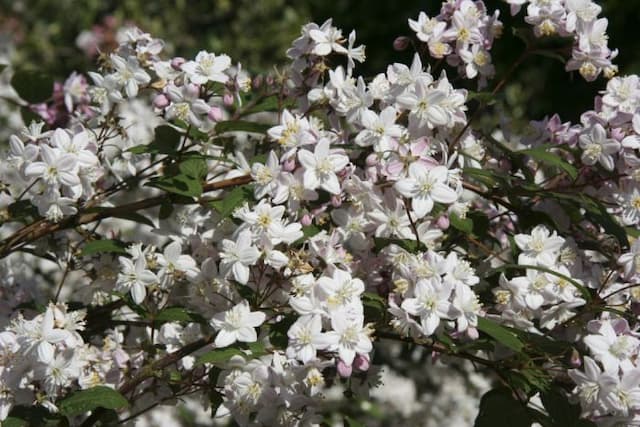Mountain Hydrangea Hydrangea serrata 'Miyama-yae-murasaki' (L/d)

ABOUT
The Hydrangea commonly known as Miyama-yae-murasaki displays an array of visually stunning features that are characteristic of its cultivar. This deciduous shrub showcases lush, green foliage that provides a vibrant backdrop for its remarkable blooms. The leaves are broadly ovate with pointed tips and toothed edges, creating a textured effect. The true stars of the show, however, are the plant's flowers. The blooms are formed in rounded clusters known as corymbs, which become the focal point of the shrub during flowering season. Each cluster is a combination of tiny, fertile flowers surrounded by larger, sterile flowers, contributing to the full, opulent appearance of the flower head. The color of the blossoms is a captivating shade of deep violet or purple, often with a subtle blue undertone, that can transform depending on the soil pH. In the center of the sterile flowers, there are hints of lighter shades, adding an appealing contrast and depth to the overall floral display. The buds initially appear as small spheres, gradually opening up to reveal double blooms, which indicates the presence of more than one layer of petals per flower, giving the blossoms a lush, multi-dimensional look. The delightful aspect of Miyama-yae-murasaki's flowering comes from this layered petal structure that resembles the intricate beauty of lace. Even when not in full bloom, the plant maintains its ornamental value through its leaves and branching structure, creating a pleasing aesthetic throughout the growing season. The visual interest of this Hydrangea endures into the fall when the leaves may acquire a slightly different hue, adding a warm touch to the cool days of autumn.
About this plant
 Names
NamesSynonyms
Mountain Hydrangea, Tea of Heaven
Common names
Hydrangea serrata 'Miyama-yae-murasaki'
 Toxicity
ToxicityTo humans
Mountain hydrangea (Hydrangea serrata) is known to contain compounds that can release cyanide when chewed or digested. If ingested, parts of the plant such as the leaves or flowers can cause symptoms of poisoning, which might include stomach upset, nausea, vomiting, and diarrhea. In some cases, more severe symptoms such as difficulty breathing, dizziness, or even convulsions can occur if large amounts are consumed. It is advisable to avoid ingesting any part of the mountain hydrangea and to seek medical attention immediately if poisoning is suspected.
To pets
Mountain hydrangea (Hydrangea serrata) is toxic to pets such as cats and dogs. The plant contains cyanogenic glycosides, which can release cyanide when the plant material is chewed and ingested. Symptoms of poisoning in pets can include gastrointestinal upset, vomiting, diarrhea, lethargy, and in severe cases, depression, difficulty breathing, and increased heart rate. If a pet is suspected of eating any part of the mountain hydrangea, it is important to seek veterinary care immediately as ingestion can be harmful and potentially life-threatening.
 Characteristics
CharacteristicsLife cycle
Perennials
Foliage type
Deciduous
Color of leaves
Green
Flower color
Purple
Height
4 feet (1.2 meters)
Spread
4 feet (1.2 meters)
Plant type
Shrub
Hardiness zones
6
Native area
Japan
Benefits
 General Benefits
General Benefits- Ornamental appeal: The Hydrangea serrata 'Miyama-yae-murasaki' is a popular ornamental plant known for its beautiful and abundant purple flowers that add aesthetic value to gardens and landscapes.
- Shade tolerance: This variety of hydrangea can tolerate partial shade, making it a versatile choice for gardeners with shaded areas.
- Seasonal interest: With its flowering period in the summer and attractive foliage that sometimes changes color in fall, this hydrangea provides visual interest throughout the growing season.
- Compact size: Being a relatively small shrub, it is well-suited for smaller gardens or limited spaces.
- Cultural significance: Hydrangeas have various cultural associations in different societies; for example, they are associated with gratitude and apologies in Japan, adding a layer of cultural depth to the garden.
 Medical Properties
Medical PropertiesThis plant is not used for medical purposes.
 Air-purifying Qualities
Air-purifying QualitiesThis plant is not specifically known for air purifying qualities.
 Other Uses
Other Uses- Hydrangea serrata tea can be made from the leaves, which is a traditional refreshing beverage in some parts of Japan, imparting a mild sweet taste.
- Dried hydrangea flowers are used for craft purposes, including the creation of wreaths, arrangements, and in potpourri to provide an aesthetic appearance and subtle fragrance to living spaces.
- The vibrant colored blossoms of the hydrangea can be used to make natural dyes for textiles, yielding soft hues of blue, pink, or purple, depending on the soil pH level.
- As an ornamental plant, hydrangeas can be used in bonsai art, where the plants are carefully pruned and shaped to make miniature landscapes or artistic forms.
- Pressed hydrangea flowers are popular in scrapbooking and card making for their variety of colors and detailed textures.
- Photographers often use hydrangea gardens as a backdrop for wedding or portrait photography thanks to the lush and romantic setting they provide.
- Hydrangeas are sometimes used in educational settings as an example to teach about soil pH and its effect on plant coloration, due to the flower's unique ability to change color based on soil acidity.
- In some cultures, hydrangeas are used symbolically in festivals or ceremonies to represent gratitude, grace, and abundance.
- Gardeners may use the timing of hydrangea blooms as a phenological indicator for planting other species, due to the plant's sensitivity to changes in temperature and daylight.
- Hydrangeas can be cultivated to create living fences or privacy screens in landscaping, providing an attractive and dense barrier during blooming seasons.
Interesting Facts
 Feng Shui
Feng ShuiThe Mountain Hydrangea is not used in Feng Shui practice.
 Zodiac Sign Compitability
Zodiac Sign CompitabilityThe Mountain Hydrangea is not used in astrology practice.
 Plant Symbolism
Plant Symbolism- Understanding: Hydrangeas can symbolize a desire to deeply comprehend someone or convey heartfelt emotion due to their complex, multi-layered appearance.
- Gratitude: Giving hydrangeas is traditionally a way to express thanks for being understood or to show appreciation for someone's kindness.
- Abundance: With their lush, voluminous blooms, hydrangeas are often associated with abundance and prosperity.
- Beauty: Hydrangeas are admired for their beautiful and varied colors, symbolizing beauty or vanity in some cultures.
- Heartfelt Emotions: The intense hues and fullness of the hydrangea blooms can signify the overflowing emotions of love or passion, especially when given as a gift.
- Apology: Some hydrangea colors, particularly blue, can represent an apology, remorse, or a desire for reconciliation.
 Water
WaterMountain hydrangea, commonly referred to as Hydrangea serrata 'Miyama-yae-murasaki', requires consistent moisture and should be watered deeply once a week with about 1 gallon of water per plant. During hot or dry weather, watering frequency should increase to twice per week to ensure the soil remains moist but not soggy. Avoid overhead watering to reduce the risk of leaf diseases and instead aim the water at the base of the plant. If the plant is in a container, ensure adequate drainage and water until it runs out of the pot's bottom.
 Light
LightMountain hydrangea thrives in partial shade with morning sunlight and afternoon shade, or filtered sunlight throughout the day. Avoid placing it in full afternoon sun, especially in hotter climates, as this can lead to leaf scorch. The ideal spot for the plant would be an area that receives dappled sunlight under the canopy of larger trees or on the north or east side of a building.
 Temperature
TemperatureMountain hydrangeas prefer a temperate climate, with ideal growth temperatures between 60°F and 75°F. These plants can tolerate minimum temperatures down to 20°F but should be protected from harsh frosts. During the summer months, ensure the plants are shielded from extreme heat as temperatures above 80°F can be detrimental to their well-being.
 Pruning
PruningPrune mountain hydrangeas immediately after flowering to encourage next year's blooms as they flower on old wood. Cut back the flowering stems by about one third to a healthy set of buds to maintain plant shape and vigor. It's rarely necessary to heavily prune these plants, but if needed, do so no later than early fall to avoid removing the buds for the next blooming season.
 Cleaning
CleaningAs needed
 Soil
SoilThe Mountain Hydrangea prefers moist, well-drained soil rich in organic matter. The ideal soil pH for this plant is slightly acidic, ranging from 5.5 to 6.5. A mix containing equal parts of garden soil, peat moss, and perlite or coarse sand facilitates good drainage and aeration. Mulching is beneficial to conserve moisture and provide nutrients.
 Repotting
RepottingMountain Hydrangea should be repotted every 2 to 3 years. It's best to repot in late winter or early spring, before the onset of the new growth period. When repotting, choose a container that is slightly larger than the previous one to allow space for root growth.
 Humidity & Misting
Humidity & MistingMountain Hydrangea thrives in environments with average to high humidity. They perform best when the relative humidity level is between 40% and 70%. Protect them from dry air, particularly during winter when indoor heating can reduce indoor humidity levels.
 Suitable locations
Suitable locationsIndoor
Place in bright, indirect light and maintain high humidity.
Outdoor
Partial shade, shelter from harsh sun, and protect from strong wind.
Hardiness zone
6-9 USDA
 Life cycle
Life cycleThe life cycle of the Mountain Hydrangea 'Miyama-yae-murasaki' begins with seed germination, occurring in moist, well-drained soil with partial shade, typically in late winter or early spring. After germination, seedlings emerge and establish a rosette of leaves, gradually developing into a small shrub. Vegetative growth continues as the plant matures, producing serrated, green leaves and eventually forming woody stems. This hydrangea variety reaches flowering maturity after a few years, whereupon it produces clusters of violet to blue double-flowered blossoms in summer, with the exact color influenced by the soil pH. After the bloom, if pollination occurs, the flowers develop into small capsule-like fruits, releasing seeds for dispersal by wind or rain. As colder weather approaches, the plant enters into dormancy, shedding leaves if grown in a climate with cold winters, and resuming growth and bloom in the subsequent spring.
 Propogation
PropogationPropogation time
Spring-Early Summer
The most popular method of propagation for the Mountain Hydrangea 'Miyama-yae-murasaki' is through softwood cuttings. This process involves taking a cutting that is about 4-6 inches long from a healthy, new growth stem in late spring or early summer. The lower leaves of the cutting should be stripped off, and the cut end dipped in a rooting hormone to encourage root growth. The prepared cutting is then placed in a well-draining potting mix, ensuring at least two sets of leaf nodes are below the surface. The cutting should be kept in a warm, humid environment with indirect light until it establishes roots, which typically takes 2-4 weeks. During this time, it's crucial to maintain consistent moisture but avoid waterlogging the soil, which can lead to rot.







![Hydrangea [Early Sensation]](/_next/image?url=https%3A%2F%2Fplants-admin.emdemapps.com%2Fimages%2Fplants%2F%2Fimages%2F604b6150338db.png&w=640&q=75)

